Built-in Widget and Dialog Classes
Qt provides a complete set of built-in widgets and common dialogs that cater for most situations. In this section, we present screenshots of almost all of them. A few specialized widgets are deferred until later: Main window widgets such as QMenuBar, QPopupMenu, and QToolBar are covered in Chapter 3, and database widgets such as QDataView and QDataTable are covered in Chapter 12. Most of the built-in widgets and dialogs are used in the examples presented in this book. In the screenshots below, the widgets are shown using the classic Windows style.
Figure 2.17. Qt's button widgets

Qt provides three kinds of "buttons": QPushButton, QCheckBox, and QRadioButton. QPushButton is most commonly used to initiate an action when it is clicked, but it can also behave like a toggle button (click to press down, click to release). QRadioButtons are usually used inside a QButtonGroup and are mutually exclusive within their group, whereas QCheckBox can be used for independent on/off options.
Figure 2.18. Qt's container widgets
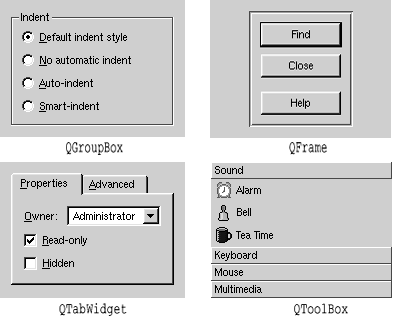
Qt's container widgets are widgets that contain other widgets. QFrame can also be used on its own to simply to draw lines and is inherited by many other widget classes, notably QLabel and QLineEdit. QButtonGroup is not shown; it is visually identical to QGroupBox.
QTabWidget and QToolBox are multi-page widgets. Each page is a child widget, and the pages are numbered from 0.
Figure 2.19. Qt's item view widgets
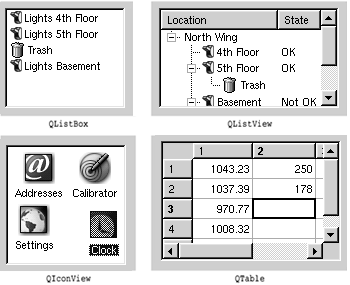
The item views are optimized for handling large amounts of data, and often use scroll bars. The scroll bar mechanism is implemented in QScrollView, a base class for item views and other kinds of views.
Figure 2.20. Qt's display widgets

Qt provides a few widgets that are used purely for displaying information. QLabel is the most important of these, and it can be used for showing rich text (using a simple HTML-like syntax) and images.
QTextBrowser (not shown) is a read-only QTextEdit subclass that has basic HTML support including lists, tables, images, and hypertext links; Qt Assistant uses QTextBrowser to present documentation to the user.
Figure 2.21. Qt's input widgets
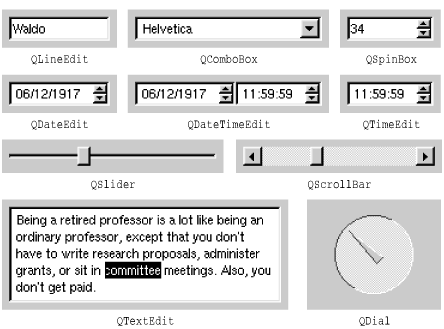
Qt provides many widgets for data entry. QLineEdit can restrict its input using an input mask or a validator. QTextEdit is a QScrollView subclass capable of editing large amounts of text.
Figure 2.22. Qt's color dialog and font dialog

Qt provides the standard set of common dialogs that make it easy to ask the user to select a color, font, or file, or to print a document.
Figure 2.23. Qt's file dialog and print dialog
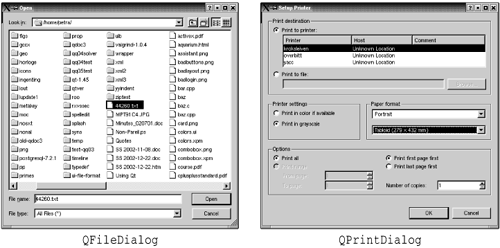
On Windows and Mac OS X, Qt uses the native dialogs rather than its own common dialogs when possible.
Figure 2.24. Qt's feedback dialogs
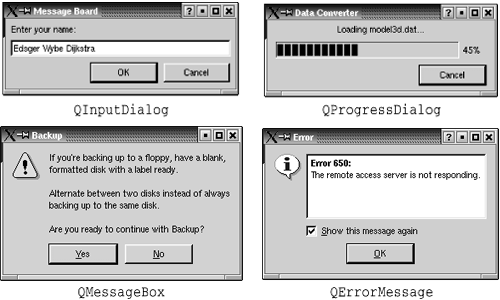
Qt provides a versatile message box and an error dialog that remembers which messages it has shown. The progress of time-consuming operations can be indicated using QProgressDialog or using the QProgressBar shown earlier. QInputDialog is very convenient when a single line of text or a single number is required from the user.
Finally, QWizard provides a framework for creating wizards. Qt Designer provides a "Wizard" template for creating wizards visually.
Figure 2.25. Qt's QWizard dialog
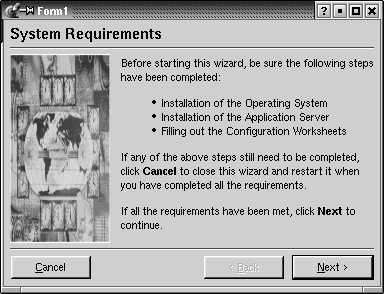
A lot of ready-to-use functionality is provided by the built-in widgets and common dialogs. More specialized requirements can often be satisfied by connecting signals to slots and implementing custom behavior in the slots.
In some situations, it may be desirable to create a custom widget from scratch. Qt makes this straightforward, and custom widgets can access all the same platform-independent drawing functionality as Qt's built-in widgets. Custom widgets can even be integrated with Qt Designer so that they can be used in the same way as Qt's built-in widgets. Chapter 5 explains how to create custom widgets.
Part I: Basic Qt
Getting Started
Creating Dialogs
- Creating Dialogs
- Subclassing QDialog
- Signals and Slots in Depth
- Rapid Dialog Design
- Shape-Changing Dialogs
- Dynamic Dialogs
- Built-in Widget and Dialog Classes
Creating Main Windows
- Creating Main Windows
- Subclassing QMainWindow
- Creating Menus and Toolbars
- Implementing the File Menu
- Setting Up the Status Bar
- Using Dialogs
- Storing Settings
- Multiple Documents
- Splash Screens
Implementing Application Functionality
- Implementing Application Functionality
- The Central Widget
- Subclassing QTable
- Loading and Saving
- Implementing the Edit Menu
- Implementing the Other Menus
- Subclassing QTableItem
Creating Custom Widgets
- Creating Custom Widgets
- Customizing Qt Widgets
- Subclassing QWidget
- Integrating Custom Widgets with Qt Designer
- Double Buffering
Part II: Intermediate Qt
Layout Management
- Layout Management
- Basic Layouts
- Splitters
- Widget Stacks
- Scroll Views
- Dock Windows
- Multiple Document Interface
Event Processing
- Event Processing
- Reimplementing Event Handlers
- Installing Event Filters
- Staying Responsive During Intensive Processing
2D and 3D Graphics
Drag and Drop
Input/Output
- Input/Output
- Reading and Writing Binary Data
- Reading and Writing Text
- Handling Files and Directories
- Inter-Process Communication
Container Classes
Databases
Networking
XML
Internationalization
- Internationalization
- Working with Unicode
- Making Applications Translation-Aware
- Dynamic Language Switching
- Translating Applications
Providing Online Help
- Providing Online Help
- Tooltips, Status Tips, and Whats This? Help
- Using QTextBrowser as a Simple Help Engine
- Using Qt Assistant for Powerful Online Help
Multithreading
- Multithreading
- Working with Threads
- Communicating with the GUI Thread
- Using Qts Classes in Non-GUI Threads
Platform-Specific Features
EAN: 2147483647
Pages: 140
